You are here
- Home
- Publications and reports
- Data insights
- Measuring participation in adult learning: new targets, methods and data
Measuring participation in adult learning: new targets, methods and data
Summary
Raising adult (25- to 64-year-olds) participation in lifelong learning has been a key objective of European vocational education and training (VET) policy for more than two decades. To perform their jobs effectively and improve career and job opportunities, Europe’s ageing workforce needs continue to learn to manage the accelerating technological change that is transforming jobs and tasks.
Reflecting its importance, the European Union (EU) has set several targets for desirable levels of participation in adult learning. However, targets, methods and data for counting participation in adult learning under the current, post-2020, European VET policy cycle, have changed. They differ significantly from those used in previous policy cycles of 2002-10 and 2010-20. This insight discusses the differences between the new and old targets, methods and data. It considers some issues on the definition of adult participation in lifelong learning and present a selection of updated key figures in the EU.
New targets, counting methods and data sources
Post-2020 European VET policy, in the 2021 Council Resolution on the European Education Area, sets a target of 47% of adults participating in learning by 2025. Under the 2021 European Pillar of Social Rights Action Plan, this target rises to 60% by 2030. These targets are considerably higher than those set in earlier VET policy cycles of 12.5% by 2010 and 15% by 2020. The difference in the old and new targets is largely explained by the new method of measuring participation in adult learning.
- In line with Eurostat Classification of Learning Activities (CLA), adult participation continues to be measured with respect to the concepts of formal and non-formal learning. For technical and practical reasons, informal and random learning by adults continue not to be considered for key headline statistics and quantitative target setting.
- On the other hand, while targets in the 2002-10 and 2010-20 policy cycles counted learning that took place in the previous four weeks, the post-2020 European target counts learning by adults that took place in the previous 12 months. This approach is now regarded as more appropriate for supporting policy making and monitoring.
The longer reference period for participation in learning explains the leap from a target of 15% in 2020 to one of 60% by 2030.
For the post-2020 VET policy cycle, the 2020 European skills agenda sets two other targets for adult participation in learning.
- The first is to raise participation of adults with low levels of education to 30% by 2025. This target uses the new method of counting learning that took place in the previous 12 months.
- The second target is to raise the share of unemployed adults with a recent learning experience to 20% by 2025. To better align with the labour market concept of unemployment status, this target counts learning that took place in the previous four weeks.
LFS and AES: different approach
In the earlier 2002-10 and 2010-20 European VET policy cycles, data on participation in adult learning was collected annually by the European Labour Force Survey (LFS), which has traditionally been measuring participation in adult learning in the previous four weeks. Adult participation in learning over the previous 12 months was measured by the Adult Education Survey (AES). However, the AES is carried out every six years. To inform European VET policy development and implementation, the EU needs a more frequent data source to measure participation in adult learning and progress towards the target.
Consequently, the LFS has been enriched to include variables that capture participation in adult learning over a 12-month period and report the data every two years. The first LFS data of this kind was collected in 2022 and is now available. It can potentially be compared with the 2022 round of the AES.
While both surveys cover both formal and non-formal learning, measure participation in the previous 12 months, and apply overall the same concepts and definitions, the AES and LFS are different survey vehicles. This can lead to different results due to several key reasons (more detailed methodological information is available here):
- Survey purpose (time, space, attention devoted to learning at methodological and fieldwork level, including interviewer training);
- Coverage of non-formal learning (part of non-formal learning occurs as 'guided on-the-job training' (GOJT)). This category, which is important for policy and statistical reasons, is covered only in the AES as the efforts it requires to be properly measured are difficult to afford in the LFS);
- Variables for non-formal learning (the set of variables and categories for deriving the concept of non-formal learning are different across the surveys);
- National questionnaires (the number and the wording of questions to derive relevant variables and categories can differ across surveys as well as their position in the questionnaire);
- Use of proxies (proxy answers, i.e. not provided directly by the designated respondent, are more common in the EU-LFS than it is the case in the AES).
In line with Eurostat perspective, Cedefop views the AES as the most reliable source for comprehensive and more accurate measurement of participation in adult learning. However, its less frequent data collection limits its effectiveness for short-term monitoring. Consequently, the LFS has traditionally been considered a sub-optimal but viable data source. This is even more relevant now, given that the LFS has extended the coverage of adult learning activities from the past 4 weeks to the past 12 months. Having a single reference indicator and one reference source for frequent monitoring of participation in adult learning has clear advantages. At the same time, it is crucial that LFS data be complemented and contextualised with information from the AES.
Implications for monitoring progress
The 2020 Skills Agenda indicated the EU LFS as the reference source for the overall participation rate in adult learning as of 2022. The 2021 Council Resolution on the European Education Area also stated the EU LFS as the reference source for follow up monitoring from 2022 onwards. Considering the recent change in LFS methodology , the Resolution considered the target subject to confirmation and invited to compare the results of AES and LFS, to inform discussions and, if needed, changes to the LFS methodology, or the level of the target.
As far as statistics are concerned, data on participation in adult learning for 2022 are available from the LFS and the AES. From the former, estimates necessarily excludes GOJT, since it is not covered in the survey. From the AES, overall estimates can be derived separately, excluding or including GOJT. Estimates from the 2016 AES, excluding GOJT, were used at the time of setting the targets. This was because it was the only data available at that time that measured participation in adult learning in the past 12 months and could potentially align with the expected, more frequent LFS data, which was intended to become the future reference.
The question is therefore which data source should be used for monitoring progress towards the target from 2022 onwards.
Focussing on 2022, with LFS relevant data being collected for the first time, some institutions make use of both 2022 LFS and AES data. When in need of prioritising or choosing a single source to assess progress towards the established target, the 2022 AES data, excluding guided on the job training, may be given preference.
Cedefop has adopted the multi-source, multi indicator approach in the Key Indicators on VET, and the second approach in the European VET policy dashboard, aligning with preliminary indications from the Standing Group on Indicator and Benchmarks (SGIB) and the Employment Committee Indicator Group (EMCO IG).
Progress: old and new targets
In the previous policy cycle, participation in adult learning (counting learning that took place in the previous four weeks) did not increase by much. The EU did not meet its target of 15% by 2020. Participation peaked at 10.8% in 2019, before dropping to 9.1% in 2020, probably due to the COVID-19 pandemic.
Looking beyond 2020, adult participation in lifelong learning in the previous four weeks stood at 12.7% in 2023, with an upward trend over since 2021 (Figure 1).
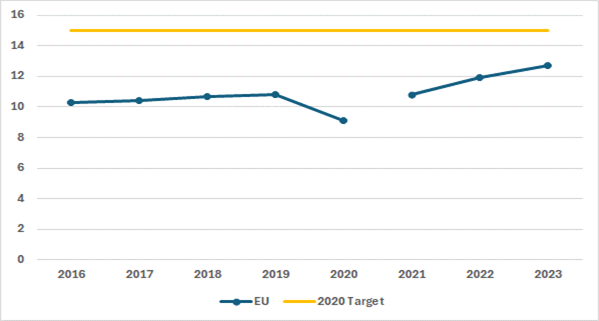
Source: Eurostat, EU LFS. NB Due to break in time series. data from 2021 onwards are not comparable with those for previous years.
In the post-2020 European VET policy cycle, using the new method of counting learning that took place in the previous 12 months, the best estimate to assess progress towards the new targets comes from the latest AES rounds (Figure 2). Based on data excluding guided on the job training, the participation rate in formal or non-formal learning was 39.5% in 2022, slightly up as compared to the 37.4% in 2016, but still below the targets of 47% by 2025 and of 60% by 2030.
Figure 2. Adults (25–64-year-olds) with a learning experience in the last 12 months (%), 2016 and 2022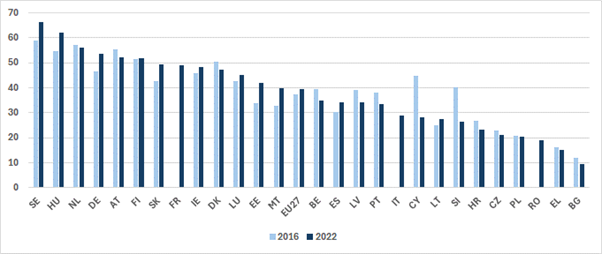
Source: Eurostat, AES, data supplied at Cedefop request and excluding participation in guided on the job training as per expected EU LFS standards; Cedefop uses these data until 2024 LFS data become available. 2016 data for France, Italy and Romania are not comparable with those for 2022, due to break in time series and are not displayed.
Participation in learning, in the previous 12 months, by adults with low levels of education, according to the latest AES data, was 17.9% and 18.9% in the EU overall, respectively in 2016 and 2022(Figure 3). This compares to the target of 30% by 2025.
Figure 3. Low-qualified adults with a learning experience in the last 12 months (%), 2016 and 2022.
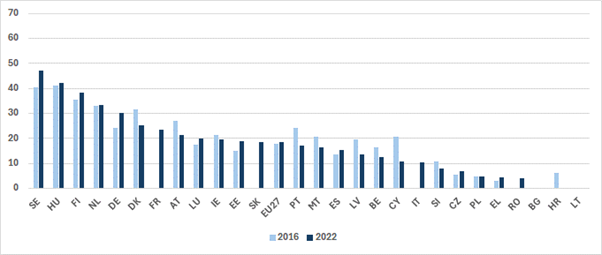
Source: Eurostat, AES, data supplied at Cedefop request and excluding participation in guided on the job training as per expected EU LFS standards; Cedefop uses these data until 2024 LFS data become available. 2016 data for France, Italy and Romania are not comparable with those for 2022 due to break in time series and are not displayed, as well as other data points which are not sufficiently reliable to be published.
During 2015-20, the share of unemployed adults with a recent learning experience (learning that took place in the previous four weeks) increased from 9.3% in 2015 to 10.5% in 2020. It has continued going up since 2021, to stand at 14.1 % in 2023, yet, short of the target of 20% by 2025 (Figure 4).
Figure 4. Unemployed adults with a learning experience in the last 4 weeks (%). EU, 2015-2023.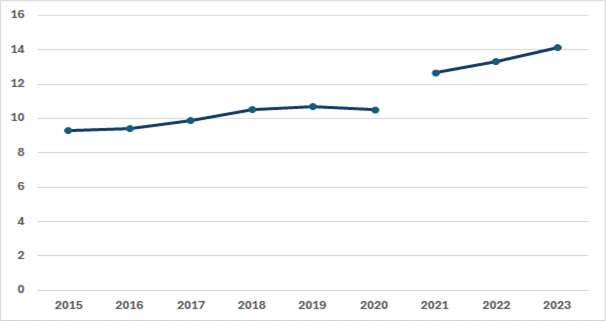
Source: Eurostat, EU LFS. NB Due to break in time series. data from 2021 onwards are not comparable with those for previous years.
What type of learning counts?
The definition of the learning that is counted is fundamentally important. The LFS definition of learning includes participation by adults in formal and non-formal learning but excludes an important component of the latter which is ‘guided-on-the-job training’ (GOJT). The AES definition of non-formal learning includes GOJT. This is because, by purpose, design and characteristics, AES can sustain the methodological elements required to capture a concept which is deemed important but particularly difficult to properly convey, understand and measure in a survey. This has not been assessed to be the case for LFS, at least thus far.
GOJT can be defined as planned periods of learning, typically sponsored by an employer in favour of workers, carried out using normal tools of work, with the presence of a designated tutor and taking place either at the immediate place of work or in a work-situation.
Looking at 2022 AES data for the EU as a whole, excluding GOJT, the participation rate in adult learning that took place in the previous 12 months, is estimated at 39.5%. Including GOJT raises this participation rate to 46.6%, close to the target of 47% by 2025 in the 2021 Council Resolution on the European Education Area (Figure 5).
Even after controlling for guided on the job training, the 2022 LFS data deliver a considerably lower participation rate in adult learning in the past 12 months compared to the corresponding 2022 AES data. The discrepancy persists even when GOJT is excluded from the AES estimate to make the datasets more comparable, with a 14.4 percentage points difference) (Figure 5).
The explicit inclusion of guided on the job training in the overall estimates of participation in adult learning, is possible only when using the AES. The argument for including guided on-the-job training is not only statistical. Based on Cedefop analysis of AES data, participation in adult learning is mostly non-formal, job-related and employer-sponsored in the EU. The 2020 Osnabrück declaration further encourages stakeholders efforts for work-based learning and on-the-job learning to stand out in the context of Continuing Vocational Education and Training (CVET) strategies. Excluding GOJT from the measurement of participation in adult learning may result in levels, patterns and trends in participation not fully reflecting such efforts.
Figure 5: Adults with a learning experience in the past 12 months (%), EU, 2016 and 2022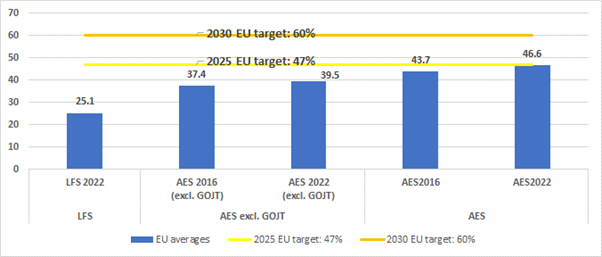
Source: Eurostat: LFS and AES
Relying solely or primarily on more frequent EU LFS data for assessing progress toward the targets will inevitably involve coverage and methodological differences, at least until a revision of the underlying methods and standards will take place for the related LFS variables to minimise some of the issues. Given these limitations, the LFS can be now considered a sub-optimal, yet more frequent, option for measuring participation in adult learning in the past 12 months and for monitoring progress towards the stated policy target.
However, if the AES were to become involved in target monitoring, or even replace the LFS, artificially excluding GOJT would not fully reflect the AES's potential and strengths. This approach might also not align with the overall policy context and the diverse ways in which non-formal adult learning takes place or it is expected to evolve in the EU. While the initial targets were set using AES data excluding GOJT once the desired measure, source, and baselines are established, there could be scope to keep or even revise targets.
About "Data insights"
‘Data Insights’ comment on selected statistical indicators relating to vocational education and training (VET). They are part of Cedefop’s continuing effort to increase availability, quality, relevance, analysis, use and dissemination of statistical information and evidence on VET and adult learning.
Data insights are drawn from Cedefop’s Key indicators on VET, a high-quality data framework that provides a concise and internationally comparable statistical picture of strategic aspects of initial and continuing VET, adult learning, skill development and their context. The indicators provide data for the European Union overall, its Member States and a selection of other European countries. Data are presented in interactive charts and include EU and country specific time series.
A subset of indicators is used for Cedefop’s European VET policy dashboard, which presents a comparative statistical snapshot of progress by the EU and its Member States towards the agreed quantitative targets and other priorities of post-2020 European VET policy (which covers the period 2021 to 2025/30).
Annex
A1. Indicators labels, descriptions and sources
| Indicator label | Indicator description and source |
Adults (25–64-year-olds) with a learning experience in the last 4 weeks (%) | Percentage of the population aged 25-64 who participated in formal or non-formal education and training over the four weeks prior to the survey. (Eurostat, LFS) |
| Adults (25–64-year-olds) with a learning experience in the last 12 months (%) | Percentage of the population aged 25-64 who participated in formal or non-formal education and training over the twelve months prior to the survey (Eurostat, AES, data supplied at Cedefop request and excluding participation in guided on the job training; Cedefop uses these data up until relevant 2024 LFS data become available). Some estimates are here presented coming from the LFS as well as from the AES and including guided on the job training (where relevant, this is indicated in the text or in the source of charts and tables). |
| Low-qualified adults with a learning experience in the last 4 weeks (%) | Percentage of the population aged 25-64 with lowest level of educational attainment (ISCED 0-2) who participated in formal or non-formal education and training over the four weeks prior to the survey. (Eurostat, LFS) |
| Low-qualified adults with a learning experience in the last 12 months (%) | Percentage of the population aged 25-64 with lowest level of educational attainment (ISCED 0-2) who participated in formal or non-formal education and training over the 12 months prior to the survey. (Eurostat, AES, data supplied at Cedefop request and excluding guided on the job training; Cedefop uses these data up until relevant 2024 LFS data become available) |
| Unemployed adults with a learning experience in the last 4 weeks (%) | Percentage of the unemployed adults (aged 25-64) who participated in formal or non-formal education and training over the four weeks prior to the survey. (Eurostat, LFS) |
A2. Abbreviations
| LFS | European Union labour force survey |
| AES | Adult Education Survey |
Data insights details
Downloads
Full article (pdf version): Measuring participation in adult learning: new targets, methods and data
Table of contents
Page 1
SummaryPage 2
New targets, counting methods and data sourcesPage 3
Progress: old and new targetsPage 4
What type of learning counts?Page 5
About "Data insights"Page 6
Annex
